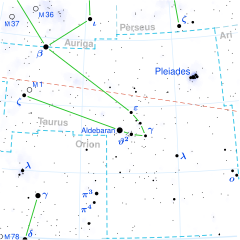
Summary
72 Tauri (abbreviated 72 Tau) is a possible binary star in the zodiac constellation of Taurus. It is faintly visible to the naked eye with an apparent visual magnitude of +5.5, although only 0.29° from the brighter υ Tauri. Based upon an annual parallax shift of 7.9 mas seen from Earth, it is around 410 light years from the Sun.
| Observation data Epoch J2000.0 Equinox J2000.0 (ICRS) | |
|---|---|
| Constellation | Taurus |
| Right ascension | 04h 27m 17.4508s[1] |
| Declination | +22° 59′ 46.778″[1] |
| Apparent magnitude (V) | 5.514[2] |
| Characteristics | |
| Evolutionary stage | main sequence[1] |
| Spectral type | B7V[3] |
| U−B color index | −0.48[4] |
| B−V color index | −0.10[4] |
| Astrometry | |
| Radial velocity (Rv) | 32.2±1.1[5] km/s |
| Proper motion (μ) | RA: −1.409[1] mas/yr Dec.: −13.722[1] mas/yr |
| Parallax (π) | 7.9390 ± 0.398 mas[1] |
| Distance | 410 ± 20 ly (126 ± 6 pc) |
| Absolute magnitude (MV) | +0.21[6] |
| Details | |
| Mass | 3.47[1] M☉ |
| Radius | 2.8[1] R☉ |
| Luminosity | 185[1] L☉ |
| Surface gravity (log g) | 3.97[1] cgs |
| Temperature | 12,689[1] K |
| Rotational velocity (v sin i) | 115[7] km/s |
| Age | 38[8] Myr |
| Other designations | |
| Database references | |
| SIMBAD | data |
Properties edit
72 Tauri is a B-type main sequence star with a stellar classification of B7V.[3] With a mass of 3.48 M☉ and an estimated age of 38 million years,[8] it is 2.8 times the size of the Sun and 185 times its luminosity.[1]
Occasionally this star system is given the Bayer designation υ2 Tauri with υ Tauri, which is separated from it by 0.29° in the sky.[4] υ Tauri is a foreground star, the two are unrelated,[11] and although 72 Tauri lies near the Hyades open cluster, it is much further away.[1]
72 Tauri lies near the ecliptic and can be occulted by the moon. Observations of an occultation in 1985 showed that it was a binary star with the two components separated by 0.1″.[12] There has been no confirmation of this finding and other sources list the star as single.[13]
References edit
- ^ a b c d e f g h i j k l m Vallenari, A.; et al. (Gaia collaboration) (2023). "Gaia Data Release 3. Summary of the content and survey properties". Astronomy and Astrophysics. 674: A1. arXiv:2208.00211. Bibcode:2023A&A...674A...1G. doi:10.1051/0004-6361/202243940. S2CID 244398875. Gaia DR3 record for this source at VizieR.
- ^ Høg, E.; et al. (2000). "The Tycho-2 catalogue of the 2.5 million brightest stars". Astronomy and Astrophysics. 355: L27–L30. Bibcode:2000A&A...355L..27H.
- ^ a b Mooley, Kunal; et al. (July 2013). "B- and A-type Stars in the Taurus-Auriga Star-forming Region". The Astrophysical Journal. 771 (2): 24. arXiv:1306.0598. Bibcode:2013ApJ...771..110M. doi:10.1088/0004-637X/771/2/110. S2CID 2176170. 110.
- ^ a b c Hoffleit, D.; Jaschek, C. (1991). The Bright Star Catalogue. New Haven: Yale University Observatory. Bibcode:1991bsc..book.....H.
- ^ Gontcharov, G. A. (November 2006). "Pulkovo Compilation of Radial Velocities for 35 495 Hipparcos stars in a common system". Astronomy Letters. 32 (11): 759–771. arXiv:1606.08053. Bibcode:2006AstL...32..759G. doi:10.1134/S1063773706110065. ISSN 1063-7737. S2CID 119231169.
- ^ Anderson, E.; Francis, Ch. (2012). "XHIP: An extended hipparcos compilation". Astronomy Letters. 38 (5): 331. arXiv:1108.4971. Bibcode:2012AstL...38..331A. doi:10.1134/S1063773712050015. S2CID 119257644.
- ^ Freire Ferrero, R.; et al. (February 2012). "High Ionization Species in the Nearby Interstellar Medium from an Exhaustive Analysis of the IUE INES Database". The Astronomical Journal. 143 (2): 38. Bibcode:2012AJ....143...28F. doi:10.1088/0004-6256/143/2/28. 28.
- ^ a b Gullikson, Kevin; Kraus, Adam; Dodson-Robinson, Sarah (25 July 2016). "The Close Companion Mass-ratio Distribution of Intermediate-mass Stars". The Astronomical Journal. 152 (2): 40. arXiv:1604.06456. Bibcode:2016AJ....152...40G. doi:10.3847/0004-6256/152/2/40. eISSN 1538-3881.
- ^ "72 Tau". SIMBAD. Centre de données astronomiques de Strasbourg. Retrieved 2017-08-05.
- ^ Kostjuk, N. D. (2004). "VizieR Online Data Catalog: HD-DM-GC-HR-HIP-Bayer-Flamsteed Cross Index (Kostjuk, 2002)". VizieR On-line Data Catalog: IV/27A. Originally Published in: Institute of Astronomy of Russian Academy of Sciences (2002). 4027. Bibcode:2004yCat.4027....0K.
- ^ Vallenari, A.; et al. (Gaia collaboration) (2023). "Gaia Data Release 3. Summary of the content and survey properties". Astronomy and Astrophysics. 674: A1. arXiv:2208.00211. Bibcode:2023A&A...674A...1G. doi:10.1051/0004-6361/202243940. S2CID 244398875. Gaia DR3 record for this source at VizieR.
- ^ Qian, B. -C; Zhu, G. -L.; Fan, Q. -Y. (1987). "The measurements of stellar angular diameter by photoelectric observation of lunar occultation". Acta Astronomica Sinica. 28: 45. Bibcode:1987AcASn..28...39Q.
- ^ Eggleton, P. P.; Tokovinin, A. A. (September 2008). "A catalogue of multiplicity among bright stellar systems". Monthly Notices of the Royal Astronomical Society. 389 (2): 869–879. arXiv:0806.2878. Bibcode:2008MNRAS.389..869E. doi:10.1111/j.1365-2966.2008.13596.x. S2CID 14878976.



